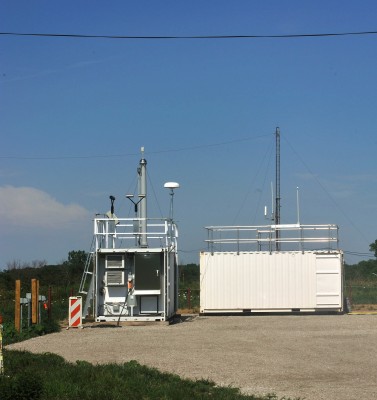Alphabet Soup: Radars for MAGIC
Published: 7 August 2012
Editor’s note: As part of the preparations for the upcoming Marine ARM GPCI Investigations of Clouds (MAGIC) field campaign, principal investigator Ernie Lewis provided information about the types of radars that will be used during the campaign.

The radio waves used for radars are grouped into bands, each band covering a range of frequencies. Most of the bands consist of frequencies greater than those used for FM radio, which in turn are greater than those frequencies used for AM radio. Some of the main radar bands have rather cryptic designations, like L, S, C, X, K, Ka, and W. “L” stands for “long,” as the wavelengths are longer than those used in S-band radars, where “S” stands for “short”. L-band radars are used (among other purposes) for long-range air traffic control, whereas S-band radars are used for air traffic control at airports. The X-band was so named because the frequency was a secret during WW2. “K” stands for “kurz,” which is German for “short” (different viewpoints on what is short, I suppose). Ka-band radars have frequencies just above K-band radars, hence the “a.” Among other uses, Ka-band radars are employed by police to detect speeding motorists.
The two main radars that will be used during MAGIC are a Ka-band radar and a W-band radar. Ka-band and W-band radars have traditionally been thought of as cloud radars, meaning they are used to detect primarily cloud drops, whereas C- and S-band (and more recently X-band) radars have traditionally been thought of as precipitation radars, as they readily detect raindrops. This distinction isn’t strictly valid, however, as Ka-band radars can also provide some information on precipitation.
The interaction between electromagnetic radiation such as radio waves and an object such as a cloud drop or a raindrop depends mainly on the frequency of the radiation and the size of the object. Thus, radars of different bands will yield different results when aimed at a cloud or at a rainstorm, and radars of different bands can be used together to provide information about the numbers and sizes of the cloud drops or raindrops.
Besides the frequency of the wave and the size of the object, the interaction of radio waves with an object also depends on the shape of the object and its composition. Thus radars can determine whether objects being detected are cloud drops or ice crystals, for instance, or whether objects are birds, insects, or water drops. When cleverly employed, radars can determine how fast raindrops are falling, from which they can infer the sizes of the drops.
–Ernie Lewis, MAGIC principal investigator
The ARM Climate Research Facility is a DOE Office of Science user facility. The ARM Facility is operated by nine DOE national laboratories, including .
Keep up with the Atmospheric Observer
Updates on ARM news, events, and opportunities delivered to your inbox
ARM User Profile
ARM welcomes users from all institutions and nations. A free ARM user account is needed to access ARM data.


















